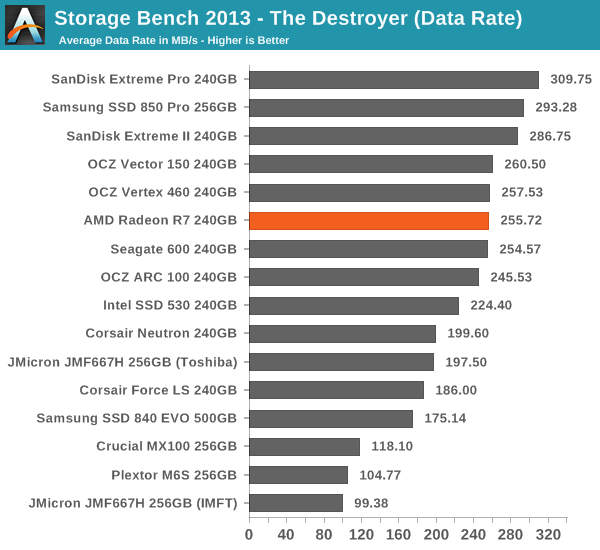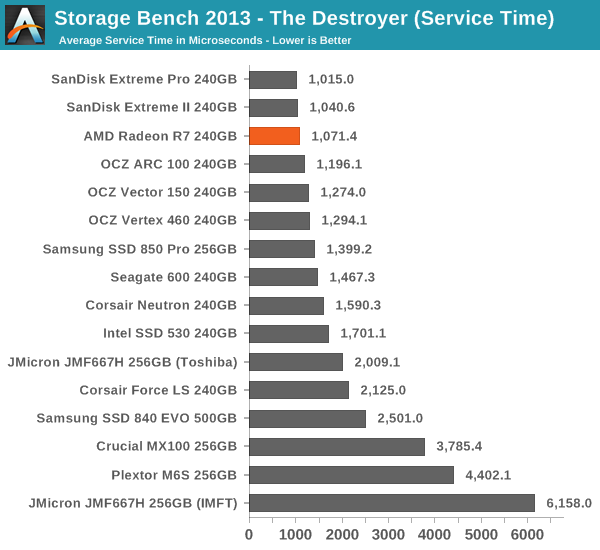AMD Radeon R7 SSD (240GB) Review
by Kristian Vättö on August 28, 2014 6:00 AM ESTAnandTech Storage Bench 2013
Our Storage Bench 2013 focuses on worst-case multitasking and IO consistency. Similar to our earlier Storage Benches, the test is still application trace based – we record all IO requests made to a test system and play them back on the drive we are testing and run statistical analysis on the drive's responses. There are 49.8 million IO operations in total with 1583.0GB of reads and 875.6GB of writes. I'm not including the full description of the test for better readability, so make sure to read our Storage Bench 2013 introduction for the full details.
| AnandTech Storage Bench 2013 - The Destroyer | ||
| Workload | Description | Applications Used |
| Photo Sync/Editing | Import images, edit, export | Adobe Photoshop CS6, Adobe Lightroom 4, Dropbox |
| Gaming | Download/install games, play games | Steam, Deus Ex, Skyrim, Starcraft 2, BioShock Infinite |
| Virtualization | Run/manage VM, use general apps inside VM | VirtualBox |
| General Productivity | Browse the web, manage local email, copy files, encrypt/decrypt files, backup system, download content, virus/malware scan | Chrome, IE10, Outlook, Windows 8, AxCrypt, uTorrent, AdAware |
| Video Playback | Copy and watch movies | Windows 8 |
| Application Development | Compile projects, check out code, download code samples | Visual Studio 2012 |
We are reporting two primary metrics with the Destroyer: average data rate in MB/s and average service time in microseconds. The former gives you an idea of the throughput of the drive during the time that it was running the test workload. This can be a very good indication of overall performance. What average data rate doesn't do a good job of is taking into account response time of very bursty (read: high queue depth) IO. By reporting average service time we heavily weigh latency for queued IOs. You'll note that this is a metric we have been reporting in our enterprise benchmarks for a while now. With the client tests maturing, the time was right for a little convergence.

Performance in our 2013 Storage Bench is typical Barefoot 3, although it appears that both the R7 and ARC 100 are more optimized for small IOs given that they provide a lower service time, yet the data rate is marginally slower.











54 Comments
View All Comments
formulav8 - Thursday, August 28, 2014 - link
Was that not mainly their Sandforce drives?haukionkannel - Thursday, August 28, 2014 - link
OCZ Vertex was better than for example Samsun 840 evo in the last test that I read about (the Extreme II was the winner though...) But in any way OCZ quality has gone up big steps!Samus - Thursday, August 28, 2014 - link
You won't find somebody that's had worse luck than myself with OCZ SSD's (having purchased many of their first SSD products including the RevoDrive in 2010) but although most of their older products failed on me (some in days, some in years) the second RevoDrive I'm on has been reliable for 3 years and amazingly my Agility 2 still hasn't failed (quite an anomaly when you Google the results of this drives inherent unreliability across the internet.)However, my personal Vector 150 and Vertex 460 haven't done anything weird at all, and I've been so happy with them from a price/performance standpoint I've begun, for the first time even, putting OCZ products (with the exception of PC Power & Cooling PSU's) in corporate PC's for clients and at work. No failures so far. The Vertex 460, cheaper than most Samsung SSD's - my usual go-to performance SSD's, is noticeably more responsive.
Still if you're looking for a cheap reliable SSD based on facts, a used Intel SSD320 on eBay or a Crucial MX100 are sure bets. But for performance Barefoot is very, very good, while still appearing to be very reliable.
AnnihilatorX - Thursday, August 28, 2014 - link
I thought OCZ is now owned by Toshiba, you can't imagine Toshiba would keep the bad quality control in OCZ uncheckedsnuuggles - Thursday, August 28, 2014 - link
Really? Triple negative? :)mapesdhs - Saturday, August 30, 2014 - link
Stop posting FUD that's thoroughly outdated by later tech.I have more than 40 OCZ SSDs, never had a problem with any of them, everything
from lots of V2Es/V3s to V4, Vector and Vector 150. I also have various Samsung,
Crucial, Corsair and other models.
OCZ's later products were really good, especially the Vertex4 and Vector range.
Their mistake was allowing the 1st gen Vertex, Octane and Solid models to be
just too much on the budget side. Ditto the old Agility, though the Agility3 and
especially the Agility4 are ok (I have a few).
Ian.
kyuu - Tuesday, September 2, 2014 - link
Your opinion of OCZ is a few years out of date.Laststop311 - Thursday, August 28, 2014 - link
You are leaving out the best ssd put there. Samsung has 100% vertical integration on the ssd. From the nand, to the controller, to the firmware, to the dram, Samsung makes it all. Why do you think samsung was first to market with TLC and 3d nand? All their teams can work together and get new products to market super fast.errorr - Friday, August 29, 2014 - link
Well the process tech is a completely separate issue from their integration. If you look at Toshiba's new fabs and tech their shrink will allow them to hit similar price points with much better nand dies that are faster and last longer.willis936 - Thursday, August 28, 2014 - link
Good to see honest journalism. Things like an amd button on the front page had me nervous.